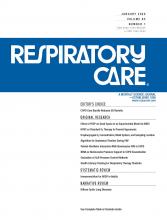In a study of subjects with liver transplantation published in the current issue of Respiratory Care, Gaspari et al1 assessed whether preventive use of oxygen therapy delivered by high-flow nasal cannula (HFNC) reduced postextubation hypoxemia more effectively than did oxygen therapy delivered with an air-entrainment mask (standard O2). Twenty-nine subjects were prospectively recruited into the HFNC group. These were matched 1:1 with 29 historical controls (standard O2 group). Contrary to expectations, the incidence of hypoxemia at 1 h and 24 h after extubation was similar in both groups. In addition, ICU length of stay and 28-d mortality were similar in both groups.
The nonsuperiority of HFNC over standard oxygen therapy in postoperative subjects reported by Gaspari et al1 is in agreement with the results of similar studies, which included subjects who had undergone major abdominal surgery,2 lung resection,3 or cardiac surgery (both obese4 and normal weight) subjects.5 Based on this and previous studies, can we state that HFNC should not be used in postoperative patients? No. HFNC likely has some advantages and a role in the management of postoperative patients.
When compared with conventional oxygen therapy, HFNC offers a number of benefits. Among them, it reduces anatomic deadspace in a way that conventional oxygen therapy does not.6 It also decreases the work of breathing, partly through applying a small amount of PEEP (typically ∼3 cm H2O for typical flows).7 But these effects would not have much, if any, effect on the more common causes of postoperative hypoxemia, such as atelectasis, aspiration, or pneumonia.8
The equivalence in hypoxemia seen in the study by Gaspari et al,1 which was not expected, may not be surprising because of the protocols for oxygen delivery. The FIO2 in both groups of subjects was titrated to maintain an SpO2 of ≥93%. If there were a difference in hypoxemia between the groups, the difference could indicate a failure of staff to recognize hypoxemia and/or differences in the ease of use of the 2 systems, instead of superiority of one modality over the other. An unexpected finding in the current study was the trend toward lower re-intubation in the HFNC group. This finding could have reached statistical significance with an even slightly larger sample size. Based on this, should we start routinely using HFNC therapy to prevent postoperative intubation?
For a few reasons, it is premature to do so. First, the finding did not reach statistical significance. Second, the pathophysiology of postoperative respiratory failure is very heterogenous.8 Third, the risk of postoperative respiratory failure varies with the surgical procedure. For example, one study found that, after abdominal aortic aneurysm repair, subjects were 11 times more likely to require prolonged mechanical ventilation; after thoracic surgery, 5.9 times more likely; and after upper abdominal surgery, 3.4 times more likely.9 Patients who have received a liver transplantation are extremely complex, and it is not clear that the findings of this study are applicable to patients who have undergone less-complex procedures. The investigators also included a subset of subjects with liver transplantation: those extubated in the ICU, not those extubated in the operating room. It is also important to note that the current study examined the prevention of respiratory failure not the treatment of respiratory failure once it develops.
The results of Gaspari et al1 also do not discourage the use of HFNC in postoperative patients. It is conceivable that HFNC could lead to hyperoxemia, which is increasingly recognized as harmful.10 This study did not demonstrate more hyperoxemia in the high-flow group. Postoperative respiratory failure is a very common problem, and one with a high mortality rate.11 How best to support these patients is a topic that needs larger studies, with more heterogenous patient populations.
Footnotes
- Correspondence: Stephen W Littleton MD, Edward Hines Junior VA Hospital, 5000 S 5th Avenue, Hines, IL.
See the Original Study on Page 21
- Copyright © 2020 by Daedalus Enterprises











